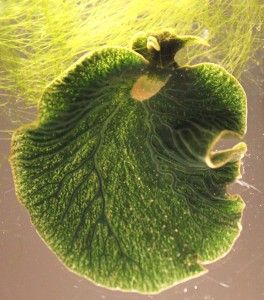There are times when I ask myself why I chose a career in science. This happens on what I call “grass is greener” days. On these days I dream of other careers—like National Geographic reporter or Caribbean tour guide–which all sound way more exciting than scientist. Admittedly these alternative careers are not ones that many people have the privilege of attaining, but sometimes reality gets to take a vacation. Fortunately, science is a fast-moving, always-changing field. As much as I might occasionally dream of exotic jobs in far away locations, science always pulls me back in with something new and unexpected. Because as much as we’d like to think we know, the truth is there is so much more that we don’t.

A case in point—sea slugs. These unfortunately named, exotic looking creatures have some surprising secrets. It is well known that certain species of herbivorous sea slugs (Sacoglossa) utilize a process called kleptoplasty, where algal chloroplasts are phagocytosed, sequestered and put to use by the slug’s digestive cells. These captured plastids, called kleptoplasts, photosynthesize inside the slug cells for a period of time that can range from hours to months, and provide some energy to the slugs. You can read a review of this process in sacoglossa sea slugs in this article (1). What has only recently come to light is that a certain species of sea slug (Elysia chlorotica), which maintains association with chloroplasts from the algal (Vaucheria litorea) it eats for 9 months or more, appears to have acquired functional nuclear genes from its food. These transferred genes help maintain the function of the plastids within the slug cells.
Evidence of algal nuclear genes coding for chloroplast proteins has been found in both adult and larval E. chlorotica using PCR and real time PCR assays (2–5) as well as transcriptome sequencing of RNA from adult slugs (6–7). All these studies found that algal nuclear genes have transferred from alga to slug cells, have integrated into slug cell biology, are transmitted to the next generation and are actively transcribed and translated in the slugs. However, when scientist performed genomes sequencing on E. chlorotica egg ribbons (unhatched larvae), they did not find any algal sequences (8).
Faced with these opposing results, a group of scientist decided to answer the question of the presence of algae genes in the E. Chlorotica genome by going right to the source—the chromosomes of unhatched E. Chlorotica larvae. They used fluorescence in situ hybridization (FISH) to probe the E. Chlorotica chromosomes for the algae nuclear gene prk. By using unhatched larvae, which have never been exposed to algae, the researchers eliminated the possibility any positive results could result from an external source of the algae DNA sequence. The researchers chose the prk gene for two reasons. One, previous studies had found evidence of its horizontal transfer between the algae V. litorea and E. Chlorotica. Second, the prk gene encodes a protein that is used exclusively in the Calvin cycle and has no known homolog in non-photosynthetic organisms.
The results, visualized using fluorescent microscopy, showed that the fluorescent probe made using the coding sequence of the prk gene bound to chromosomes of unhatched E. Chlorotica larva. Although the authors could not say for sure that the same chromosome was labeled in every preparation, the label never appeared on more than two chromosomes from each nuclear spread.
Although the FISH labeling results go a long way to putting to rest the question of whether gene transfer between algae and sea slugs occurred, there are many questions that still have no answer. The biggest of these being the mechanism of gene transfer. Because this is the only know example of functional gene transfer between two multi cell species, and this type of transfer is at the heart of how scientist envision gene therapy working one day, the mechanism through which this occurred in sea slugs is of significant interest.
This research exemplifies the reason I chose science and one of the reasons I will never run off to be a tour guide or National Geographic reporter. Science is never dull, and this world we live in still has plenty of secrets to reveal.
References
- Cruz, S., et al. (2013) J. Exp. Bot. 64, 3999–4009.
- Pierce, S., et al. (2007) Symbiosis 43, 57–64.
- Rumpho, M., et al. (2008) Proc. Natl. Acad. Sci. USA 105, 17867–17871.
- Rumpho, M., et al. (2009) Mol. Plant 2, 1384–1396.
- Schwartz, J., et al. (2010) Evol. Biol. 37, 29–37.
- Soule, K. and Rumpho, M. (2009) J. Phycol. 48, 373–83.
- Pierce, S. et al. (2012) Mol. Biol. Evol. 29, 1549–56.
- Bhattacharya, D. et al. (2013) Mol. Biol. Evol. 30, 1843–53.
Kelly Grooms
Latest posts by Kelly Grooms (see all)
- The Battle of Shiloh’s Angel’s Glow: Fact, Civil War Legend or Modern Myth? - July 11, 2024
- Mind Control, Mutilation and Death. The Fungal Fate That Lurks in Waiting for Emerging Periodical Cicadas - June 13, 2024
- Measles and Immunosuppression—When Getting Well Means You Can Still Get Sick - May 13, 2024
